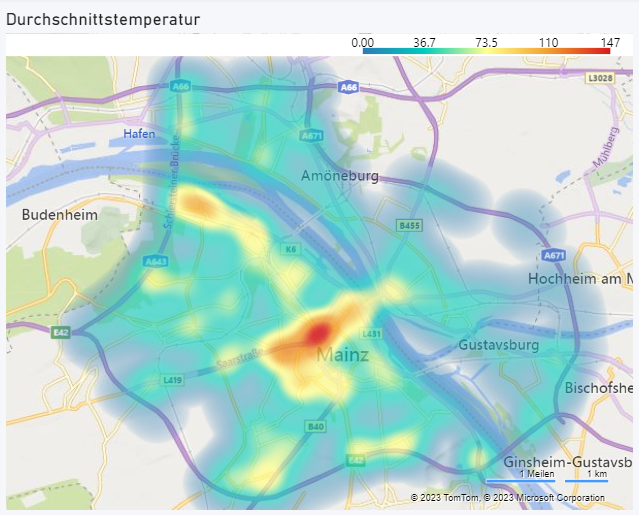Data Analysis: Better heat measures with the right data basis

Finally: Summer is coming! After the long period of cloudy winter days, every ray of sunshine is balm for the soul. But if the rising temperatures seem soothing at first, this can quickly change – and the increasing sunlight leads to heat stress. Particularly in cities, which are characterized by their high degree of sealing and limited green spaces, the heat builds up very quickly and leads to (health) impairments for citizens. What can be done about it with data?
Due to climate change, cities increasingly have to deal with intense heat periods and heat that occurs at certain points. Rising temperatures are a burden on people and the environment and already pose a major challenge for many cities. A further increase can be expected in the coming years. Cities and municipalities must therefore respond to an acute pressure to act.
Here, heat monitoring can be a great support: through targeted observation and documentation, concrete points where heat accumulates in the city – so-called heat islands – can be identified. Differentiated statements on causes and, based on this, more targeted, cost-efficient measures become possible. To obtain the necessary knowledge about the heat spots, it is necessary to collect data.
DKSR can now support municipalities in this in a simple way: With the Potential Detector for Sustainable Communities, there is a new tool with which cities and municipalities can use real-time data for analysis for heat measures without further technical infrastructure procurement. By blending various data (e.g., temperature, building coverage, vegetation), our team develops a model for monitoring heat development within the respective municipality – without any data platform at all.
Precise monitoring for targeted measures
Why “potential detector”? Quite simply: because it is about monitoring that identifies potential for new, more efficient measures within the respective municipal context. The municipalities themselves choose which questions – corresponding to the current municipal challenges – the monitoring should answer for them, e.g.
…where are there heat islands? And what causes them?
…which urban indicators (structural, vegetation, topography) characterize places with increased occurrence of heat islands?
…what planning or construction measures can be used to avoid heat islands in the future – and how can citizens best be protected?
…how can a regular reporting for the continuous reporting of inner-city heat areas look like?
In this way, municipalities receive specific analyses for their city and can ensure that the measures to be introduced are also worthwhile. After all, nothing is more annoying than rashly initiating costly actions that remain fruitless because the cause of the problem was wrongly identified.

The sustainable added value of heat island monitoring
In a comprehensive reporting, DKSR prepares the data as well as the results of the analysis for municipalities: as a report, as an interactive dashboard and in a management presentation. We identify particularly hot and particularly cool locations and, through the interaction of various data, we establish correlations between temperature and factors such as traffic volume, tree populations, subsoil, and building height. Monitoring thus provides a data-based foundation for short-term measures such as greening – which can include facade, roof and building greening, increasing tree cover and inner-city vegetation. In the long term, the information gained through monitoring can be incorporated into urban planning, e.g. for the planning of fresh air corridors.
The advantage: In order to identify heat islands, it is not absolutely necessary to constantly measure and evaluate urban temperatures. Simple reporting is also sufficient to take measures over a longer period of time: By recording the hot summer months once, valid long-term statements can be made.
Quick action without infrastructure investment
The big plus of the Potential Detector: no investment in a dedicated data platform is necessary. Heat monitoring and reporting is handled entirely by DKSR; we take care of data acquisition, processing, evaluation and visualization. We bring in a lot of data via partners, such as vehicle fleet data from our partner Mercedes Benz AG, data from sharing mobility (e.g. e-scooters) and movement data. Local sensor data from the areas of weather, buildings, water, and the environment can also be fed in. The municipality only has to provide some local data, such as base maps, vegetation data and traffic data.
Interested municipalities can get started right away and take action against summer heat. At the beginning of the cooperation with DKSR, we will discuss the specific urban conditions of the municipality in a two-hour kickoff meeting. In this way, we determine what kind of data is particularly relevant. In a subsequent workshop, we then work together to discuss specific questions that will be answered in the report and form the basis for future action.
Learn more and secure a discount as one of the first three municipalities to tackle the heat summer together with DKSR!